
If your solution to stated problem does not match the given solution, you should self-critique per instructions at
http://vhcc2.vhcc.edu/dsmith/geninfo/labrynth_created_fall_05/levl1_22/levl2_81/file3_259.htm
.
Your solution, attempt at solution. If you are unable to attempt a solution, give a phrase-by-phrase interpretation of the problem along with a statement of what you do or do not understand about it. This response should be given, based on the work you did in completing the assignment, before you look at the given solution.
At the end of this document, after the qa problems (which provide you with questions and solutions), there is a series of Questions, Problems and Exercises.
Question: `q001. Evaluate the definite integral of x^2 y^3 with respect to y, treating x as a constant, on the interval from y = - 1 to y = 2.
Your solution:
Confidence rating:
Given Solution:
Then integrate the resulting expression from x = -1 to x = 1.
We first integrate x^2 y^3 with respect to y, from y = -1 to y = 2.The definite integral of an expression on an interval is the change in its antiderivative on that interval.
Treating x as a constant and y as the variable, an antiderivative of the expression x^2 y^3 is x^2 * y^4 / 4.
On the interval from y = -1 to y = 2, the value of the antiderivative changes from x^2 * (-1)^4 / 4 = x^2 / 4 to x^2 * 2^4 / 4 = 4 x^2. The change in the antiderivative is therefore 4 x^2 - x^2 / 4 = 15/4 x^2, or 15 x^2 / 4, or in decimal form 3.75 x^2.
We integrate the resulting 15 x^2 / 4 from x = -1 to x = 1:
An antiderivative of 15 x^2 / 4 is (15/4) * x^3 / 3.
At x = -1 the value of our antiderivative is 15/4 * (-1)^3 / 3 = -15 / 12 = -5/4..
At x = 1 the value of our antiderivative is 15/4 * (1)^3 / 3 = 15 / 12 = 5/4.
The definite integral is the change 5/4 - (-5/4) = 5/2.
Our two integrals can be written in standard integral notation as
and
Our results are

and

It is clear that our second integral is an integral of the first. We call this an iterated integral.
Our first integral is the integral from -1 to 2 of x^2 y^3, with respect to y, and it gives us 15 x^2 / 4.
Our last integral, the integral from -1 to 1 of 15 x^2 / 4 with respect to x, can therefore be expressed as
The integral from -1 to 1 with respect to x, of the integral from -1 to 2 with respect to y, of the expression x^2 y^3.
We could in fact write the entire iterated integral as one single expression:
The integral from -1 to 1 with respect to x, of the integral from -1 to 2 with respect to y, of the expression x^2 y^3 can be written as
Our entire solution can be written in compact format as
Self-critique (if necessary):
Self-critique rating:
Question: `q002. In the preceding integral we integrated with respect to y over the interval from y = -1 to y = 2, then we integrated the result with respect to x over the interval from x = -1 to x = 1.
If at every point of the x interval [-1, 1] we sketch a line segment from y = -1 to y = 2, we 'fill in' a region of the xy plane. Sketch this region. Describe the region you have sketched.
Your solution:
Confidence rating:
Given Solution:
The figure below depicts a series of about ten such lines.
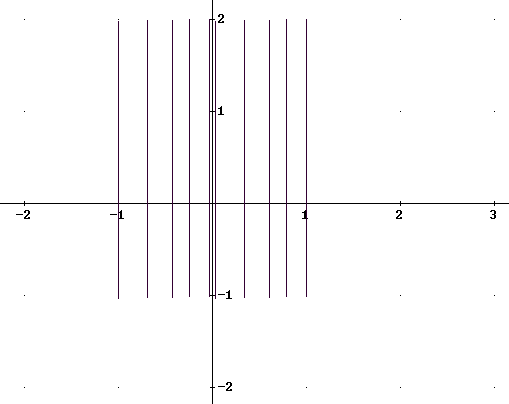
If a similar light-blue line was constructed for every point of the x interval [-1, 1] the lines would all run together. The result would appear something like the figure below:
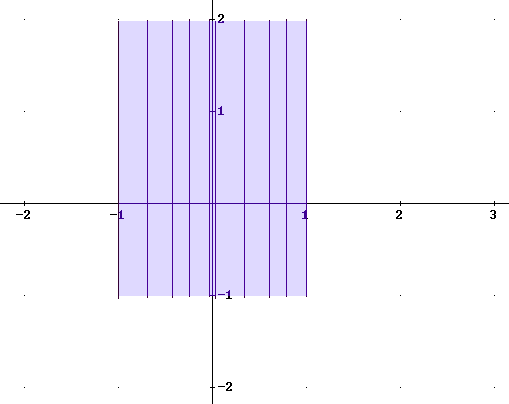
The region would be a 3 x 2 rectangle with sides parallel to the coordinate axes, with (-1, -1) and (1, 2) forming a diagonal.
For our given integral, we call this the region of integration.
Self-critique (if necessary):
Self-critique rating:
Question: `q003. Evaluate the integral of x^2 y^3 with respect to x, between the limits x = -1 and x = 1. Then integrate the resulting expression with respect to y, from y = -1 to y = 2. Compare with your solution to the first problem.
If at every point of the y interval [-1, 2] we sketch the line segment from x = -1 to x = 1, we fill in a region of the xy plane. Sketch and describe this region.
Explain how the description of the region you have sketched here compares with the description of the region you sketched in the preceding problem.
Your solution:
Confidence rating:
Given Solution:
We do the x integral first:
Regarding y as constant our antiderivative is x^3 / 3 * y^3. At x = -1 the value of the antiderivative is -y^3 / 3, at x = 1 the value is y^3 / 3, so the change in the value of the antiderivative is y^3 / 3 - (-y^3 / 3) = 2 y^3 / 3.
We now integrate the result 2 y^3 / 3 with respect to y.
Our antiderivative is y^4 / 6. At y = -1 and y = 2 our antiderivative takes values 1/6 and 16/6. The change in our antiderivative is thus 16/6 - (1/6) = 15/6 = 5/2.
Our solution written in standard form looks like this:
Note that this is the same result we obtained in the first question.
The figure below shows a series of line segments located at y coordinates ranging from y = -1 to y = 2, with each segment running from x coordinate -1 to x coordinate 1.
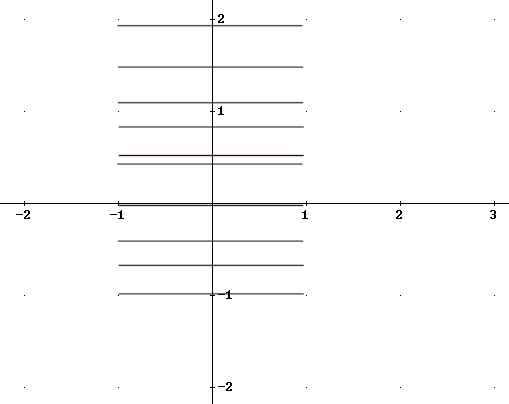
A series of similar blue line segments, one for each value of y, would give us the picture below:
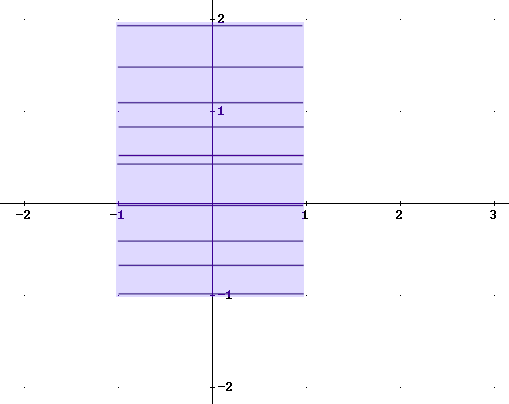
This is the region of integration for the current integral.
Note that the region of integration is identical to that of our previous integral
The function being integrated is also the same.
The two integrals

and
are said to have reverse order of integration.
We will soon see why we get identical results when the order of integration is reversed.
Self-critique (if necessary):
Self-critique rating:
Question: `q004. Evaluate the integral of x^2 y^3 with respect to y, treating x as a constant, between the limits y = 0 and y = x.
Then integrate the resulting expression from x = 0 to x = 2.
Your solution:
Confidence rating:
Given Solution:
First integrating between the y limits:
We obtain antiderivative x^2 y^4 / 4.
One of the limits on the integral is y = x. If we substitute this value of y into the antiderivative we get x^2 * x^4 / 4 = x^6 / 4.
Thus at the limits y = 0 and y = x the antiderivative takes respective values 0 and x^6 / 4.
The change in the value of the antiderivative is therefore x^6 / 4 - 0 = x^6 / 4.
Integrating this result with respect to x, between x = 0 and x = 2:
Our antiderivative is x^7 / 28.
At x = 0 and x = 2 the values of the antiderivative are respectively 0 and 32/7.
The change in our antiderivative is therefore 32/7 - 0 = 32/7.
Self-critique (if necessary):
Self-critique rating:
Question:
`q005. In the preceding integral we integrated with respect to y over the interval from y = 0 to y = x, then we integrated the result with respect to x over the interval from x = 0 to x = 2.
If at every point of the x interval [0, 2] we sketch a line segment from y = 0 to y = x, we 'fill in' a region of the xy plane. Sketch this region. Describe the region you have sketched.
Your solution:
Confidence rating:
Given Solution:
These intervals are sketched in the figure below.
If we were to sketch the line segments corresponding to all x values between 0 and 2 we would get a figure much like that below.
The region is bounded below by the x axis, above by the line y = x and on the right by the line x = 2.
The region could be describe as
0 <= x <= 2
0 <= y <= x
The preceding integral is taken over this region. The integral would be written as

Self-critique (if necessary):
Self-critique rating:
Question:
`q006. Now integrate x^2 y^3 with respect to y from y = 0 to y = sqrt(x), and integrate the resulting expression from x = 0 to x = 4.
Then sketch the corresponding region, where x varies from 0 to 4 and for every x the value of y varies from 0 to x^2.
Describe your region.
Your solution:
Confidence rating:
Given Solution:
Integrating x^2 y^3 with respect to y we get antiderivative x^2 y^4 / 4. The change in the antiderivative between y = 0 and y = sqrt(x) is x^2 (sqrt(x))^4 / 4 = x^4 / 4.
Integrating this result with respect to x we get antiderivative x^5 / 20. The change in this antiderivative between x = 0 and x = 4 is 4^5 / 20 = 256/3.
For x = 1/4 we get y = sqrt(1/4) = 1/2.
For x = 1, 2, 3, 4 we get approximate values y = 1, 1.4, 1.7, 2.
The corresponding segments are sketched below.
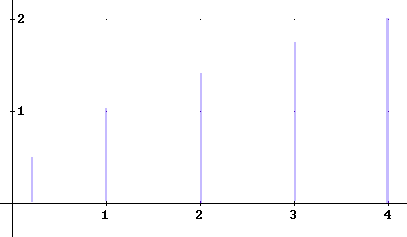
Were we to sketch all such segments we would fill the region indicated by the figure below.
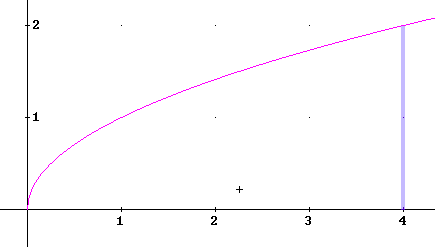
This region can be described by
0 <= x <= 4
0 <= y <= sqrt(x).
We can say that the integral of x^2 y^3 over the region has value 256/3, about equal to 85.33.
Self-critique (if necessary):
Self-critique rating:
Question:
`q007. Over what x interval does the line y = 1 intersect the region you sketched in the preceding? (The region was 0 <= x <= 4, 0 <= y <= sqrt(x))
Over what interval does the line y = 1/2 intersect the same region?
Over what interval does the line y = 3/2 intersect the region?
Over what interval does the line y = c intersect the region?
What is the maximum value of c for which the line y = c has a nonempty intersection with the region? What is the minimum such value of c?
Your solution:
Confidence rating:
Given Solution:
The line y = 1 intersects the line y = sqrt(x) when 1 = sqrt(x). This occurs when x = 1.
The figure below shows the graph of y = sqrt(x) and the line y = 1. The projection line from the intersection of the line with the curve is also indicated, showing how the intersection occurs at the x = 1 point of the curve.
It should be clear that the segment of the line y = 1 within the region runs from x = 1 to x = 4. The part of the line to the left of x = 1 lies outside the region, as does the part of the line for x > 4.
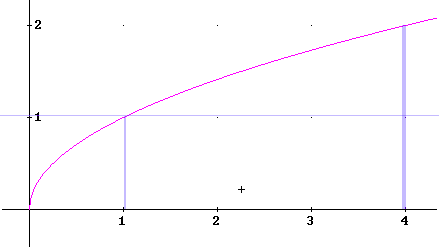
Similarly:
The line y = 1/2 intersects the curve when 1/2 = sqrt(x), so that x = (1/2)^2 = 1/4.. The segment of this line that lies within the region runs from x = 1/4 to x = 4.
The line y = 3/2 intersects the curve when 3/2 = sqrt(x), so that x = (3/2)^2 = 2 1/4 or 2.25. The segment of this line that lies within the region runs from x = 2.25 to x = 4.
The line y = c intersects the curve when c = sqrt(x), so that x = c^2. The segment of this line that lies within the region runs from x = c^2 to x = 4.
Self-critique (if necessary):
Self-critique rating:
Question:
`q008. We could describe the region of the preceding question (i.e., the region 0 <= x <= 4, 0 <= y <= sqrt(x)) as follows:
For point y of the interval [0, 2], we sketch the line segment from x = __ to x = 4.
What expression should we use to fill in the blank?
Why do we use the y interval [0, 2]?
Your solution:
Confidence rating:
Given Solution:
Since y = sqrt(x), it follows that at the intersections point x = y^2. Thus the line runs from x = y^2 to x = 4.
Since x values range from 0 to 4, the values of y = sqrt(x) range from 0 to 2.
Self-critique (if necessary):
Self-critique rating:
Question:
`q009. Integrate x^2 y^3 with respect to x, from x = y^2 to x = 4. Then integrate the result with respect to y from y = 0 to y = 2.
Sketch the region of integration, and explain in detail how you constructed your sketch.
Your solution:
Confidence rating:
Given Solution:
An antiderivative of x^2 y^3 with respect to x is x^3 y^3 / 3. Between x = y^2 and x = 4 the antiderivative changes by 4^3 * y^3 / 3 - (y^2)^3 y^3 / 3 = 64 y^3 / 3 - y^9 / 3.
An antiderivative of 64 y^3 / 3 - y^9 / 3 with respect to y is 16 y^4 / 3 - y^10 / 30. Between y = 0 and y = 2 this changes by (16 * 2^4 / 3 - 2^10 / 30) - 0 = 256 / 3.
This agrees with our previous integral of x^2 y^3 over this region.
Self-critique (if necessary):
Self-critique rating:
Question:
`q010. Consider the region 0 <= x <= 1, x^2 <= y <= 2.
If we partition the x interval from 0 to 1 into a number of small subintervals, then what part of our region corresponds to the typical subinterval, whose length we denote by `dx and which contains a sample point x_hat?
Your solution:
Confidence rating:
Given Solution:
Let's call our region R. In rigorous set notation R = { (x, y) | 0 <= x <= 1, x^2 <= y <= 2 }.
The ispecified nterval on the x axis has length `dx and contains the point x = x_hat.
The corresponding part of our region is a vertical 'strip' within the region. Intuitively it consists of all points which lie directly 'above' this interval of the x axis.
More rigorously, it consists of all points (x, y) within our region R such that x lies within the given interval.
To be within our region R, the value of y must be between x^2 and 2. So a more specific description would be the set { (x, y) | x lies in the given interval of length `dx containing x = x_hat, with x^2 <= y <= 2 }.
The figure below shows our region, with two vertical lines defining the interval `dx of the x axis (the value x = x_hat occurs somewhere within this interval) as well as the vertical 'strip' defined by the interval.
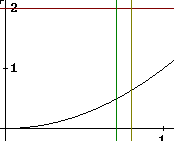
The part of the 'strip' within the region R is shaded in the figure below.
Every point of the vertical 'strip' shares its x coordinate with some point in the interval of the axis, and the x coordinate of every point of the part of the 'strip' within the region R occurs within the interval.
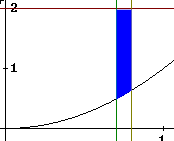
Self-critique (if necessary):
Self-critique rating:
Question: `q011. Continuing the preceding, if we partition the y interval of the 'strip' corresponding to our previous x subinterval into small subintervals, what will be the shape and dimensions of the typical subinterval whose length is `dy and which contains the sample point y_hat? What will be its area?
Your solution:
Confidence rating:
Given Solution:
The vertical 'strip' is an approximate rectangle. Its lower boundary is clearly not at right angles to its vertical side, but if `dx is small we won't be far off by regarding the 'strip' as a rectangle.
From the preceding we see that the strip runs from approximately y = x_hat^2 to y = 2, a distance of 2 - x_hat^2. We say 'approximately' because x_hat is only a representative point within our interval and does not represent all x values with complete accuracy. (More detail, which you can ignore for now unless this is bothering you: The smallest y value along the left-hand side of the 'strip' is less than the smallest y value along the right-hand side, and since x_hat lies between the left and right ends of our interval the value y = x_hat^2 lies between these two y values. A small subregion of the 'strip' therefore has y values less than x_hat^2, and another small region containing points with y values greater than x_hat^2 fail to lie within the 'strip'. However the areas of both of these regions are small compared to that of our vertical 'strip', and as we shrink our `dx interval to improve our approximation they will constitute an even smaller portion of the strip's area.)
We will therefore partition the interval from y = x_hat^2 to y = 2. The length of the typical y interval will be denoted by `dy, and it will contain a sample point y_hat. Its shape will be a rectangle with dimensions `dx by `dy, containing the point (x_hat, y_hat).
Self-critique (if necessary):
Self-critique rating:
Question: `q012. Continuing the preceding, if the density at the point (x, y) of the region is x^2 y^3, then what is the mass corresponding to the region of dimensions `dx by `dy, provided we regard the density at the point (x_hat, y_hat) to be the average density of that region?
Your solution:
Confidence rating:
Given Solution:
The density function is x^2 y^3 and the sample point within our `dx by `dy area increment is (x_hat, y_hat).
The density at our sample point is therefore x_hat ^ 2 * y_hat ^ 3.
The density at other points within our region will probably be a little different than the density at our sample point, but if our region is small enough and if the density is continuous the difference in densities will be negligible. So we are justified in saying that the approximate mass of the region is equal to the density at the sample point, multiplied by the area of the region:
`dMass = x_hat^2 * y_hat^2 * `dx * `dy.
Self-critique (if necessary):
Self-critique rating:
Question: `q013. The details will be developed in this and subsequent assignments. However the key to applying multiple integration is to figure out just what happens in the typical small increment of the region of integration, as we have just done.
Having done so it is relatively straightforward to build this knowledge into the required integral.
Recall that the typical `dx by `dy increment has approximate mass`dm = x_hat^2 y_hat^3.
If we want to find the mass of the vertical 'strip' corresponding to our `dx interval containing sample point x_hat, we first note that x_hat is the same throughout that 'strip'. Other x intervals will have different sample points, but we are only concerned for the moment with x values in the present interval, and they are all represented by x_hat.
The 'strip' is however partitioned into a number of y increments, so our y_hat values will differ as we move from one y increment to the next.
In a process you will soon see, involving Riemann sums and limits in a manner very similar to that encountered in applications of the integral in first-year calculus, we sum the contributions from our y increments and take the limit as increment length `dy approaches zero. The details of the process, as mentioned, will be encountered later. The result is that y_hat becomes just y, `dy becomes dy and the mass of the vertical strip is approximated by the integral with respect to y, from y = x_hat^2 to y = 2 of the expression x_hat^2 y^3 * `dx:
mass of vertical strip = integral( x_hat^2 y^3 * `dx dy, y from x_hat^2 to 2), approximately.
Find the value of this integral.
Your solution:
Confidence rating:
Given Solution: Our antiderivative is x_hat^2 y^4 / 4 * `dx, so the value of the integral is
x_hat^2 (2^4) / 4 * `dx - x_hat^2 (x_hat^2)^4 / 4 * `dx = ( 4 x_hat^2 - 1/4 x_hat^10) * `dx
Self-critique (if necessary):
Self-critique rating:
Question: `q014. The approximate mass of the vertical 'strip' corresponding to x interval `dx with sample point x_hat is
( 4 x_hat^2 - 1/4 x_hat^10) * `dx
If all such increments between x = 0 and x = 1 are added to form a Riemann sum, and the intervals `dx are allowed to approach zero, again through a process we will encounter shortly the effect is that x_hat becomes x, `dx becomes dx, and our sum becomes the integralintegral( (4 x^2 - 1/4 x^10) dx, x from 0 to 1).
What is the value of this integral?
Does the value make sense in terms of the densities involved and the area of our region?
Your solution:
Confidence rating:
Given Solution:
The integral is very easily evaluated. An antiderivative is 4 x^3 / 3 - x^11 / 44, and the definite integral has value
mass = 4/3 - 1/44 = 173 / 132
The area of the region is easily seen (using a calculus I techniques) to be 5/3. If you evaluate the density function at various representative points within the region you will find that it is much less than 1 at most point, and though it does reach a value of 8 at one point of the region, densities greater than 1 apply to only a small part of the region. So the average density could be close to 1. The mass of the region is 173/132, which is approximately 1.3. You should form your own opinion of how consistent the final result is with your understanding of densities and areas.
Self-critique (if necessary):
Self-critique rating:
Question: &&&
Your solution:
Confidence rating:
Given Solution:
Self-critique (if necessary):
Self-critique rating:
Question: `q015. Find the mass of the region between x = -2 and x = 2, bounded above by the curve y = 1 + x^2 and below by the positive x axis, if the density at the point (x, y) is 1 + x^2 + 3 y.
Explain the details of the entire process in a manner consistent with that illustrated by the problems and solutions provided in this document.
Your solution:
Confidence rating:
Question: `q016. Give a description of the region of integration for the integral
integral(integral( x/y dy, y from 1 to sqrt(x+1)) dx, x from 0 to 3).
Write the same integral with the order of integration reversed.
Based on the values of the function being integrated and a reasonable estimate of the area of the region, give a reasonable ball-park estimate of the integral.
Evaluate both integrals, and explain how your result is consistent with the function being integrated and the given region.
Hint: The value of the integral is between 2 and 3.
Your solution:
Confidence rating: